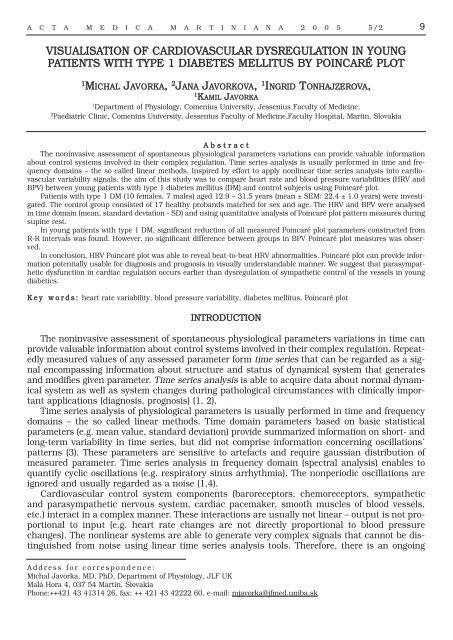MAKETA 5/2 po
MAKETA 5/2 po
MAKETA 5/2 po
You also want an ePaper? Increase the reach of your titles
YUMPU automatically turns print PDFs into web optimized ePapers that Google loves.
A C T A M E D I C A M A R T I N I A N A 2 0 0 5 5/2 9<br />
VISUALISATION OF CARDIOVASCULAR DYSREGULATION IN YOUNG<br />
PATIENTS WITH TYPE 1 DIABETES MELLITUS BY POINCARÉ PLOT<br />
1<br />
MICHAL JAVORKA, 2 JANA JAVORKOVA, 1 INGRID TONHAJZEROVA,<br />
1<br />
KAMIL JAVORKA<br />
1<br />
Department of Physiology, Comenius University, Jessenius Faculty of Medicine,<br />
2<br />
Paediatric Clinic, Comenius University, Jessenius Faculty of Medicine,Faculty Hospital, Martin, Slovakia<br />
A b s t r a c t<br />
The noninvasive assessment of s<strong>po</strong>ntaneous physiological parameters variations can provide valuable information<br />
about control systems involved in their complex regulation. Time series analysis is usually performed in time and frequency<br />
domains – the so called linear methods. Inspired by effort to apply nonlinear time series analysis into cardiovascular<br />
variability signals, the aim of this study was to compare heart rate and blood pressure variabilities (HRV and<br />
BPV) between young patients with type 1 diabetes mellitus (DM) and control subjects using Poincaré plot.<br />
Patients with type 1 DM (10 females, 7 males) aged 12.9 – 31.5 years (mean ± SEM: 22.4 ± 1.0 years) were investigated.<br />
The control group consisted of 17 healthy probands matched for sex and age. The HRV and BPV were analysed<br />
in time domain (mean, standard deviation - SD) and using quantitative analysis of Poincaré plot pattern measures during<br />
supine rest.<br />
In young patients with type 1 DM, significant reduction of all measured Poincaré plot parameters constructed from<br />
R-R intervals was found. However, no significant difference between groups in BPV Poincaré plot measures was observed.<br />
In conclusion, HRV Poincaré plot was able to reveal beat-to-beat HRV abnormalities. Poincaré plot can provide information<br />
<strong>po</strong>tentially usable for diagnosis and prognosis in visually understandable manner. We suggest that parasympathetic<br />
dysfunction in cardiac regulation occurs earlier than dysregulation of sympathetic control of the vessels in young<br />
diabetics.<br />
K e y w o r d s : heart rate variability, blood pressure variability, diabetes mellitus, Poincaré plot<br />
INTRODUCTION<br />
The noninvasive assessment of s<strong>po</strong>ntaneous physiological parameters variations in time can<br />
provide valuable information about control systems involved in their complex regulation. Repeatedly<br />
measured values of any assessed parameter form time series that can be regarded as a signal<br />
encompassing information about structure and status of dynamical system that generates<br />
and modifies given parameter. Time series analysis is able to acquire data about normal dynamical<br />
system as well as system changes during pathological circumstances with clinically im<strong>po</strong>rtant<br />
applications (diagnosis, prognosis) (1, 2).<br />
Time series analysis of physiological parameters is usually performed in time and frequency<br />
domains – the so called linear methods. Time domain parameters based on basic statistical<br />
parameters (e.g. mean value, standard deviation) provide summarized information on short- and<br />
long-term variability in time series, but did not comprise information concerning oscillations`<br />
patterns (3). These parameters are sensitive to artefacts and require gaussian distribution of<br />
measured parameter. Time series analysis in frequency domain (spectral analysis) enables to<br />
quantify cyclic oscillations (e.g. respiratory sinus arrhythmia). The nonperiodic oscillations are<br />
ignored and usually regarded as a noise (1,4).<br />
Cardiovascular control system com<strong>po</strong>nents (baroreceptors, chemoreceptors, sympathetic<br />
and parasympathetic nervous system, cardiac pacemaker, smooth muscles of blood vessels,<br />
etc.) interact in a complex manner. These interactions are usually not linear – output is not pro<strong>po</strong>rtional<br />
to input (e.g. heart rate changes are not directly pro<strong>po</strong>rtional to blood pressure<br />
changes). The nonlinear systems are able to generate very complex signals that cannot be distinguished<br />
from noise using linear time series analysis tools. Therefore, there is an ongoing<br />
Address for corres<strong>po</strong>ndence:<br />
Michal Javorka, MD, PhD, Department of Physiology, JLF UK<br />
Malá Hora 4, 037 54 Martin, Slovakia<br />
Phone:++421 43 41314 26, fax: ++ 421 43 42222 60, e-mail: mjavorka@jfmed.uniba.sk

















